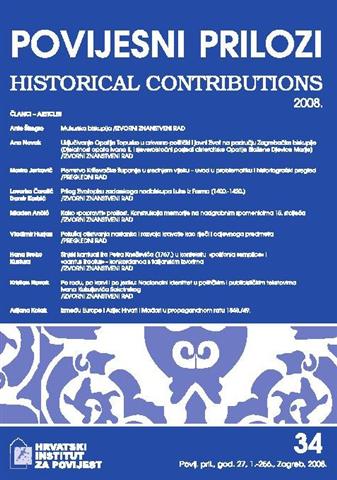Plemstvo Križevačke županije u srednjem vijeku – uvod u problematiku i historiografski pregled
Nobility of the Križevci County in the Middle Ages. An Introduction into its Research and Review of Literature
Author(s): Marko JerkovićSubject(s): History
Published by: Hrvatski institut za povijest
Keywords: the Middle Ages; the Križevci County; nobility
Summary/Abstract: This three-part article reviews the current state of research into the history of the nobility of the medieval Križevci County. It furthermore proposes the context in which this topic should be studied. The first part discusses the main issues concerning the nobility of the Križevci County, as well as nobility in general. In the discussion of the appropriate context for studying this social group, the author stresses the importance of the historical-anthropological approach, as exemplified by the work of Georges Duby and Erik Fügedi. He concludes that the micro-historical approach provides a better understanding of the social reality of certain regions than the standard historical approach to studying groups in general. The second part reviews scholarly literature on the nobility of the Križevci County. The review consists of three chapters. The first chapter discusses the scholarship studying the nobility of the Križevci County directly, as a social group, or indirectly, when studying the history of the region. It furthermore examines which questions and which geographical areas within the county have intrigued the scholars the most. It is shown that the nobility of the Križevci-Kalnik region has been studied the most, followed by the studies of the nobility of the areas of Cirkvena and Vrbovec, the regions of Garešnica-Moslavina, and finally Podravina (the areas of Ludbreg, Đurđevac and Koprivnica). Best studies are, however, on the nobility of the Rovišće area. The nobility of the southern and of the most of the county’s central areas received little attention from historians. Moreover, most historians studied social and legal status of lesser nobility and their relationships with more prominent noble families. Other authors stressed the active social role of the nobility, and tried to identify the owners of certain landed estates. There have been few case studies of noble families, with the exception of the old but comprehensive study of the Svetački family by Vjekoslav Klaić and the less detailed studies on the Mikčec, štefanović, Budor, Čuz of Ludbreg, and Paližna families. The second chapter reviews studies on the nobility of the medieval counties of Požega and Zagreb. Its aim is to offer research models and comparative cases for writing a history of Križevci nobility. The author concludes that, similar to the studies on the nobility of the Križevci County, few historians have attempted to identify noble families and kin, or to trace the continuity of the landed estates ownership.Historiography of the nobility of the Zagreb County made some important advances in studying noble women, especially concerning the institution of the quarta puellaris.Of particular importance is Marija Karbić’s dissertation on the kindred of the Banus Borić, in which she examined some anthropological and sociological issues related to the kindred. The third chapter discusses the key literature providing models for studying the nobility of the Križevci Cou
Journal: Povijesni prilozi
- Issue Year: 2008
- Issue No: 34
- Page Range: 45-69
- Page Count: 24

